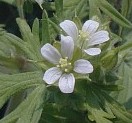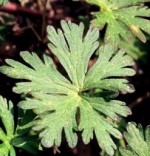 Carolina chickweed is native to Eastern United States but is known throughout North America where it is a winter annual from Zone 6 southward but a spring weed in northern areas. It likes full or partial sun, dry conditions, and sandy, gravelly, infertile soil but tolerates many soil types including acidic conditions. It easily invades disturbed areas and can be found along roadsides and other waste areas as well as in pastures, woodland, lawns and gardens.
Carolina chickweed is native to Eastern United States but is known throughout North America where it is a winter annual from Zone 6 southward but a spring weed in northern areas. It likes full or partial sun, dry conditions, and sandy, gravelly, infertile soil but tolerates many soil types including acidic conditions. It easily invades disturbed areas and can be found along roadsides and other waste areas as well as in pastures, woodland, lawns and gardens.

 Description: Young plants are small, circular rosettes that give rise to numerous, erect, pinkish and hairy stems that are branched from the base. Stems grow from 6” to 28” tall and the lower ones may sprawl on the ground. The grayish green hairy leaves are alternate on lower stems but opposite above and are palmately divided into to 3-9 primary lobes with coarse, widely spaced teeth or secondary lobes. They are borne on long hairy petioles and are about 3” long and wide. The five petaled flowers are white to pink or purple and about 1/3” across. They are borne singly or in loose clusters on short stems (pedicels) at the tips of stems in early to late summer and are followed by pods with long beaks containing five small seeds. The root system is fibrous with a short taproot.
Description: Young plants are small, circular rosettes that give rise to numerous, erect, pinkish and hairy stems that are branched from the base. Stems grow from 6” to 28” tall and the lower ones may sprawl on the ground. The grayish green hairy leaves are alternate on lower stems but opposite above and are palmately divided into to 3-9 primary lobes with coarse, widely spaced teeth or secondary lobes. They are borne on long hairy petioles and are about 3” long and wide. The five petaled flowers are white to pink or purple and about 1/3” across. They are borne singly or in loose clusters on short stems (pedicels) at the tips of stems in early to late summer and are followed by pods with long beaks containing five small seeds. The root system is fibrous with a short taproot.
 Control: Hand pulling the seedlings when they are young or hoeing as them as they mature can be effective as long as the crown is removed. Older plants tend to snap off above the crown so extra effort is necessary to remove them to avoid resprouting. Once the plant as produced seed removing them may only aid in seed dispersal. Good lawn practices such as aeration, correct mowing height, fertilizing and irrigation encourage a thick turf that decrease Carolina geranium in lawns. Postemergent herbicides containing a combination of chemicals such as dicamba, 2-4 D, fluroxypyr, mecoprop can be used when infestations are great.
Control: Hand pulling the seedlings when they are young or hoeing as them as they mature can be effective as long as the crown is removed. Older plants tend to snap off above the crown so extra effort is necessary to remove them to avoid resprouting. Once the plant as produced seed removing them may only aid in seed dispersal. Good lawn practices such as aeration, correct mowing height, fertilizing and irrigation encourage a thick turf that decrease Carolina geranium in lawns. Postemergent herbicides containing a combination of chemicals such as dicamba, 2-4 D, fluroxypyr, mecoprop can be used when infestations are great.